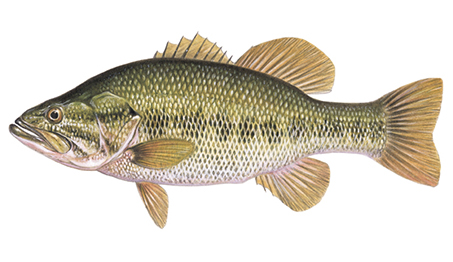Common Names: largemouth bass, largemouth, black bass, bucket mouths
Habitat
The native range of the largemouth bass was restricted to the lower Great Lakes but now, as a result of extensive introductions, the range has extended across the province in areas south of the north shore of Lake Superior (but not in Lake Superior). The largemouth is typically associated with warm water and, therefore, usually found in small lakes or in shallow bays of larger lakes. It is rare for largemouth to be found in depths greater than 20 feet. Largemouths are almost always near dense vegetation or cover like stumps, lily pads, cattails, and other aquatic vegetation.
Spawning Patterns
Spawning occurs in late spring or early summer when water temperatures reach 15 ºC (60 ºF). Spawning sites are over soft, muddy bottoms with bulrushes, lily pads or reeds. Males are very territorial at this time and spawning sites are rarely closer than 30 feet from each other. Females can produce over 100,000 eggs! Eggs usually hatch within five days but remain with the male for protection for up to a month.
Diet
Adult fish eat a wide variety of food including other fish, crayfish, frogs, and large insects. The composition of each is based on availability within the environment.
Age and Size
The growth of largemouth bass greatly varies within their range. The rate of growth is significantly higher in the more southern regions. In Ontario it typically takes 4-6 years to reach 30 cm (12”). The maximum age seems to be between 13-15 years, reaching lengths of 55 cm (22 inches) and reaching weights of around 5 lbs. Any largemouth over five pounds should be considered a trophy.
Fishing Tips
Like the smallmouth, the largemouth bass is a much sought after sport fish more often sought after for its fight than for its fillets. Most of the fish are caught during the summer months with July being most productive. When fish are in an aggressive mood, fishing with fast moving baits or top water baits offers the most excitement. During tough fishing periods switching to more subtle techniques can produce a couple of fish on an otherwise fishless day. Using plastic worms and fishing slowly through dense cover can be a very effective method. Live bait fished with a bobber is also another tactic that should not be overlooked.
Fish illustration ©CURTIS ATWATER (www.natureartists.com/atwaterc.htm)









